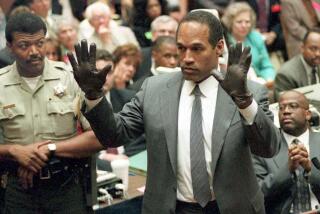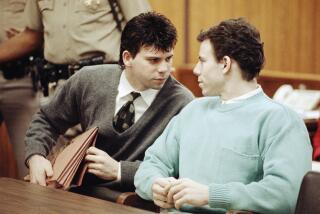Justice for All, Especially Ages 25 to 54
- Share via
NEW YORK — Court TV began broadcasting 10 years ago with the notion that courtroom dramas would make good television. Real courtrooms. Real trials. Gavel-to-gavel coverage. And replays of the day’s courtroom highlights throughout the night. Court 24/7.
More than a few lawyers thought the new network’s founders--among them law-media mogul Steve Brill--needed a competency exam. But Court TV debuted July 1, 1991, with several blockbuster trials in progress. Robert Scott Hill was being tried in Florida, charged with killing his mother-in-law 25 years earlier, a case in which Hill’s son, now a detective, was the star witness against him. Teacher Pamela Smart was on trial in New Hampshire for persuading her 17-year-old student/lover to murder her husband.
Hill was acquitted, Smart was convicted and a growing audience of courtroom junkies was riveted. Within months, they watched the William Kennedy Smith rape trial. Smith’s acquittal barely had been logged when the network began broadcasting the sanity hearings of confessed serial murderer and cannibal Jeffrey Dahmer.
Syndicated columnist Joe Bob Briggs homed in on the network within weeks. “They show the same gol’ dang trials over and over again, all day long, like MTV for lawyers,” Briggs wrote, proceeding to highlight the Christian Brando sentencing and the trials of Hill and Smart. “This stuff is great. I can’t believe these trials won’t bump soap operas off the air inside of three years. And if you think these trials are bloody, wait till they start doing divorce trials.”
Court TV had to evolve to survive. Viewers were drawn to the drama of cases being televised live, but switched to other channels at night for entertainment and sports programming. Taped trials, rebroadcast at night, had little allure.
So in 1999, Court TV revamped its prime-time schedule, replacing trials with crime and police dramas.
The network’s new slogan is “Judgment days. Sleepless nights.” Its logo is a red fingerprint. And its success is remarkable.
In June, Nielsen rated Court TV the fastest-growing cable network in the country, with subscribers up 40% over the previous year. The number hovers near 65 million. On July 8, Court TV achieved its best evening rating when 742,000 households watched its Sunday prime-time shows.
Those aren’t Super Bowl numbers by any means, but demographics are everything, and Court TV boasts the sixth-highest concentration of viewers ages 25 to 54 of the 40 cable networks monitored by Nielsen. Advertising revenues last year rose to $50 million.
Court TV navigates between information and offense. In 1999, the network broadcast “Confessions”--videotaped interrogations of murderers and rapists in police custody. Crime victims and the families of murder victims strenuously objected, and the network pulled the series after two segments. “We dealt with that quickly and in a fairly classy way,” said Henry S. Schleiff, chief executive officer of Court TV.
Emmy Award-winning TV reporter Fred Graham, who has been managing editor and chief anchor at Court TV since before its first broadcast, said he’s satisfied with the mix of live trials and entertainment since the network’s relaunch in January 1999.
“The original mission of doing real trials remains in the daytime, and at nighttime we do shows related to crime and justice. I’m happy with that,” Graham said. “You have to survive. If you recall, about four or five years ago, Court TV was about to go under and be sold to the Discovery Channel. Now we’re a bifurcated channel, and I’m very comfortable with that. We will stay in the courtroom. We have to--that’s our mission. What we do is real and absolutely riveting.”
Brill was bought out by the network in 1997 for an undisclosed amount that, Brill said recently, brought him “the financial independence anyone prizes.” The buyout came at a point when the network was stagnant and, Brill said, at a crossroads. Controlling partners Time Warner Entertainment, Liberty Media and NBC (the latter was bought out a year later) were heading toward an entertainment network. Brill wanted to broaden Court TV to local cable stations that would broadcast local trials.
“I always thought of Court TV as a news network,” Brill said last month. “As much as I like ‘NYPD Blue’ and ‘Homicide,’ I always avoided the process of getting into a bidding war to cast those reruns.”
At the anniversary party, Schleiff lavished praise on a number of veteran Court TV employees, with no mention of Brill, whose role in creating the network is undisputed.
“I’m proud to have started a business that is still there and is still thriving, and I’m proud of the coverage we did,” Brill said. “We set a standard for how trials can be covered, [including] the war crimes tribunal at the Hague [Netherlands].
“When I thought of [creating] Court TV, I had been in lots of courtrooms and had always been struck by the gap in what the public thought the process was all about, and what those of us who watched it up-close knew it was all about. People thought trials were like Clint Eastwood or Perry Mason movies. I think we did open the legal system.”
Schleiff has his sights set on gaining access to federal courts, including the U.S. Supreme Court, which currently bans cameras. “I think the opportunity we have with federal trials is huge,” he said.
As for prime time, Court TV committed to spending $140 million for original programming over the next two years, including series, movies and docudramas such as “Ghosts of Attica,” which is planned for broadcast in September--the 30th anniversary of the deadly Attica prison riot. And the network acquired the rights to rebroadcast “NYPD Blue” beginning in September. “The Secret History of Rock and Roll,” hosted by Kiss lead singer Gene Simmons, which explores how the rock scene and crime intertwine, is in the programming lineup.
Lynne Tuohy is a reporter for the Hartford Courant, a Tribune Company.
More to Read
The complete guide to home viewing
Get Screen Gab for everything about the TV shows and streaming movies everyone’s talking about.
You may occasionally receive promotional content from the Los Angeles Times.






